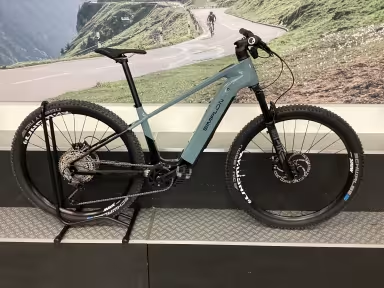
E-Bike Triathlon
E-bike triathlon is a special electric bike developed for use in triathlon competitions. Triathlon is an endurance sport consisting of swimming, cycling and running.
17265 Triathlons


Orbea E-Mtb Fully Rise M10 Myo Occasion

KTM Macina Chacana 891 Lfc

Haibike FullSeven 7.0

Brompton P-Line Electric H12L

Simplon Cure Core

Raleigh Stoker B9

TREK Powerfly+ 6 Gen 5

SPECIALIZED Turbo Levo HT

Bulls Sonic Evo 1

Centurion Lhasa R

TERN Hsd P10

Cube Kathmandu Hybrid SLX 750

Cube Kathmandu Hybrid SLX 750

Cube Kathmandu Hybrid Exc 750

Cube Kathmandu Hybrid Exc 750

Bischibikes Kopenhagen

SCOTT Axis eRIDE 10

Flyer Upstreet SL 3.10

Cube Stereo Hybrid 140 HPC Pro 750

Cube Stereo Hybrid 140 Hpc Race 750

SCOTT Aspect eRIDE 910

Moustache Mardi 27.6 Open

Moustache Friday 27 Fs Speed Single
Buying advice for: Race & Triathlon: Triathlon
Frame material
When selecting the frame material for an e-bike triathlon, lightness, stiffness and aerodynamics are particularly important in order to maximise performance and efficiency when cycling. Carbon fibre is a popular material for e-bike triathlon frames due to its lightness, stiffness and excellent aerodynamic properties. Carbon fibre frames offer an optimal combination of low weight, high strength and vibration damping. Aluminium alloys are also commonly used for e-bike triathlon frames as they offer a good balance between weight, stiffness and cost. Aluminium frames tend to be slightly heavier than carbon frames, but offer excellent stiffness and are often less expensive. They are well suited to entry-level models or riders with a limited budget. Titanium frames are a luxury option for e-bike triathlons due to their high strength, corrosion resistance and unique damping properties. Titanium frames are lightweight and robust, offering a smooth ride and a long service life.
Suspension
The suspension of an e-bike triathlon does not usually include the traditional components such as suspension forks or suspension units that are common on mountain bikes or other off-road bikes. Instead, the suspension of an e-bike triathlon focuses on the aerodynamic design of the frame and other parts of the bike to maximise efficiency and performance while cycling. The fork of an e-bike triathlon is usually stiff and lightweight to ensure precise steering and efficient energy transfer. It is often designed to be aerodynamic and minimise drag. Whilst e-bike triathlons do not usually require suspension systems like mountain bikes, they still prioritise comfort and cushioning.
Wheels
The wheel size for e-bike triathlons usually corresponds to the standard size for road bikes, namely 700C (approx. 622 mm). This size offers a good balance between rolling resistance, weight and aerodynamics and is ideal for high speeds on flat routes. The rims can be made of different materials such as aluminium alloy or carbon fibre. Carbon fibre rims are popular for e-bike triathlons as they offer a good combination of lightness, stiffness and aerodynamics. Spokes on a triathlon e-bike can also be made of different materials such as stainless steel or aluminium. High-quality spokes offer a good balance between strength and weight and contribute to the stability and durability of the wheels.
Tyres
The tyre size for e-bike triathlons generally corresponds to the standard size for racing bikes, namely 700C (approx. 622 mm). The tyre width can vary depending on personal preference and the specific requirements of the competition. For e-bike triathlons, narrow tyres are generally preferred to minimise rolling resistance and maximise speed. Tyres with a width between 23 mm and 28 mm are typical for triathlon bikes. The tread of the tyres is usually smooth or only slightly profiled to minimise rolling resistance and maximise speed. However, some tyres have special grip elements that can improve traction on wet roads.
Brakes
Disc brakes are widely used in e-bike triathlons and provide excellent braking performance regardless of weather conditions and terrain. Rim brakes or dual pivot brakes are another popular choice for triathlon e-bikes. These brakes use brake pads that press directly on the rims to slow or stop the bike. They tend to be lighter and easier to maintain than disc brakes, but may not offer the same braking performance and reliability, especially in wet conditions.
Battery motor
Triathlon e-bikes are usually equipped with powerful motors that offer a typical output of 250 to 750 watts. These motors are designed to provide fast acceleration and efficient support for triathletes on long distances. Together with a robust battery, they provide a reliable power supply for longer rides and demanding competitions. The combination of battery and motor forms the backbone of an agile and effective e-bike triathlon.
More interesting bikes

TREK Speed Concept SLR 7

Felt AR

Cube Stereo Hybrid ONE55 C:68X SLX 750 29

